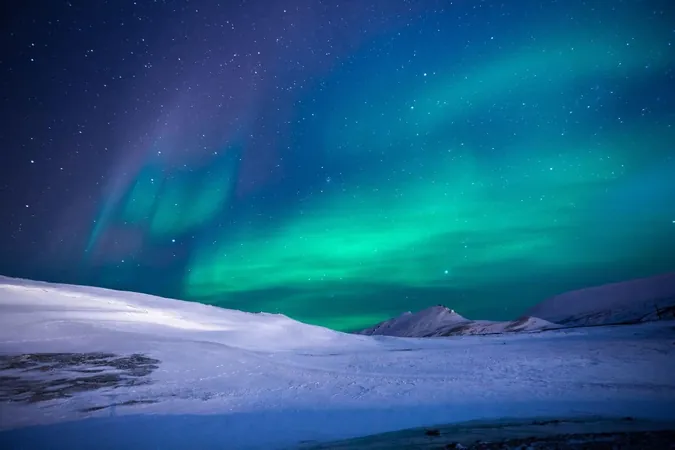
NASA's Daring Rocket Launches to Decode the Mysteries of the Northern Lights!
2025-03-24
Author: Jia
NASA's Daring Rocket Launches to Decode the Mysteries of the Northern Lights!
In an unprecedented mission aiming to revolutionize our understanding of the upper atmosphere, NASA is gearing up to launch a trio of sounding rockets from the Poker Flat Research Range in Fairbanks, Alaska. Scheduled between March 24 and April 6, this exciting experiment will delve into the enigmatic dynamics of auroral substorms and their significant impact on Earth’s thermosphere, opening new doors for space weather forecasting.
A Groundbreaking Challenge to Longstanding Theories
Dubbed AWESOME (Auroral Waves Excited by Substorm Onset Magnetic Events), this mission is set to put the traditional theory of vertical convection to the test. While scientists have long believed that vertical convection drives atmospheric disturbances during auroral events, Mark Conde, a noted space physics professor at the University of Alaska Fairbanks (UAF), suggests there’s a more complex explanation at play—acoustic-buoyancy waves.
These elusive waves can travel both vertically and horizontally, implying that the energy released during auroras could impact a broader swath of the atmosphere than researchers previously realized. If Conde's hypothesis is validated, it could dramatically alter our understanding of atmospheric dynamics.
Three Rockets, One Momentous Experiment
The ambitious launch plan features two Terrier-Improved Malemute rockets paired with a larger Black Brant XII rocket. The smaller rockets, reaching about 42 feet in length, will be dispatched approximately 15 minutes and one hour after an auroral substorm begins. They will deploy vibrant vapor tracers designed to illuminate air movements at altitudes between 50 and 110 miles. Following them, the formidable 70-foot four-stage Black Brant XII will release tracers at five designated altitudes, ranging from 68 to 155 miles.
Chasing the Waves of the Thermosphere
The primary goal of this venture is to uncover how auroral energy modifies the thermosphere—an atmospheric layer stretching from 50 to 350 miles above Earth’s surface. This region is typically characterized by stability; however, sudden magnetic energy releases during auroral substorms disrupt that balance, leading to turbulence. If acoustic-buoyancy waves take precedence, our interpretations of space weather systems may need a serious reevaluation.
Spectacular Visuals and Scientific Insight
One of the most captivating aspects of this mission is the spectacular display it promises for observers in northern Alaska. As rockets unleash vibrant pink, blue, and white vapor tracers, they will sketch visible patterns in the upper atmosphere for 10 to 20 minutes, enabling scientists to track movement dynamics using ground-based cameras. The unique conditions required for this experiment mean launches must occur at dawn, when sunlight reaches the altitudes while darkness lingers below—creating a mesmerizing sight.
Why This Research Matters Now More Than Ever
Understanding the actual mechanisms that govern auroral mixing in the thermosphere is more than an academic exercise; it is of paramount importance for practical applications. With our modern infrastructure increasingly relying on technology reliant on space-based systems—such as satellites and GPS—developing reliable models of atmospheric behavior is urgent.
Mark Conde believes that the findings from this mission could refine forecasting tools, enhancing their accuracy and providing valuable insights for future space mission planning. "I believe our experiment will lead to a simpler and more accurate method of space weather prediction," he stated confidently.
This cutting-edge research represents a pivotal moment in atmospheric science, and as these rockets soar into the auroras, they promise not only to illuminate our skies but also our understanding of the complex dance between Earth and space. Don't miss your chance to witness this groundbreaking scientific endeavor!

 Brasil (PT)
Brasil (PT)
 Canada (EN)
Canada (EN)
 Chile (ES)
Chile (ES)
 Česko (CS)
Česko (CS)
 대한민국 (KO)
대한민국 (KO)
 España (ES)
España (ES)
 France (FR)
France (FR)
 Hong Kong (EN)
Hong Kong (EN)
 Italia (IT)
Italia (IT)
 日本 (JA)
日本 (JA)
 Magyarország (HU)
Magyarország (HU)
 Norge (NO)
Norge (NO)
 Polska (PL)
Polska (PL)
 Schweiz (DE)
Schweiz (DE)
 Singapore (EN)
Singapore (EN)
 Sverige (SV)
Sverige (SV)
 Suomi (FI)
Suomi (FI)
 Türkiye (TR)
Türkiye (TR)
 الإمارات العربية المتحدة (AR)
الإمارات العربية المتحدة (AR)